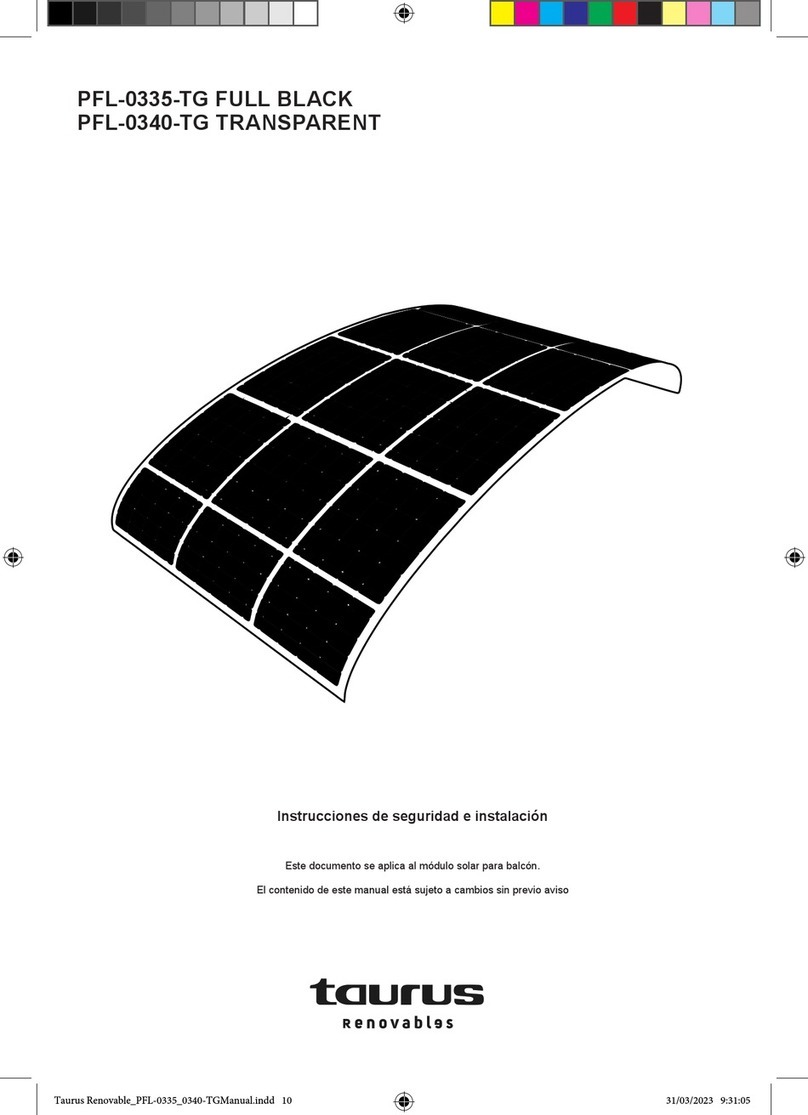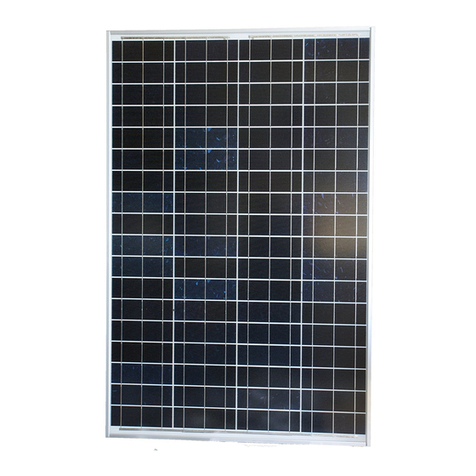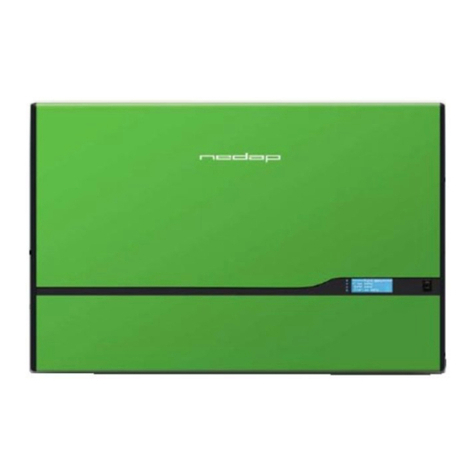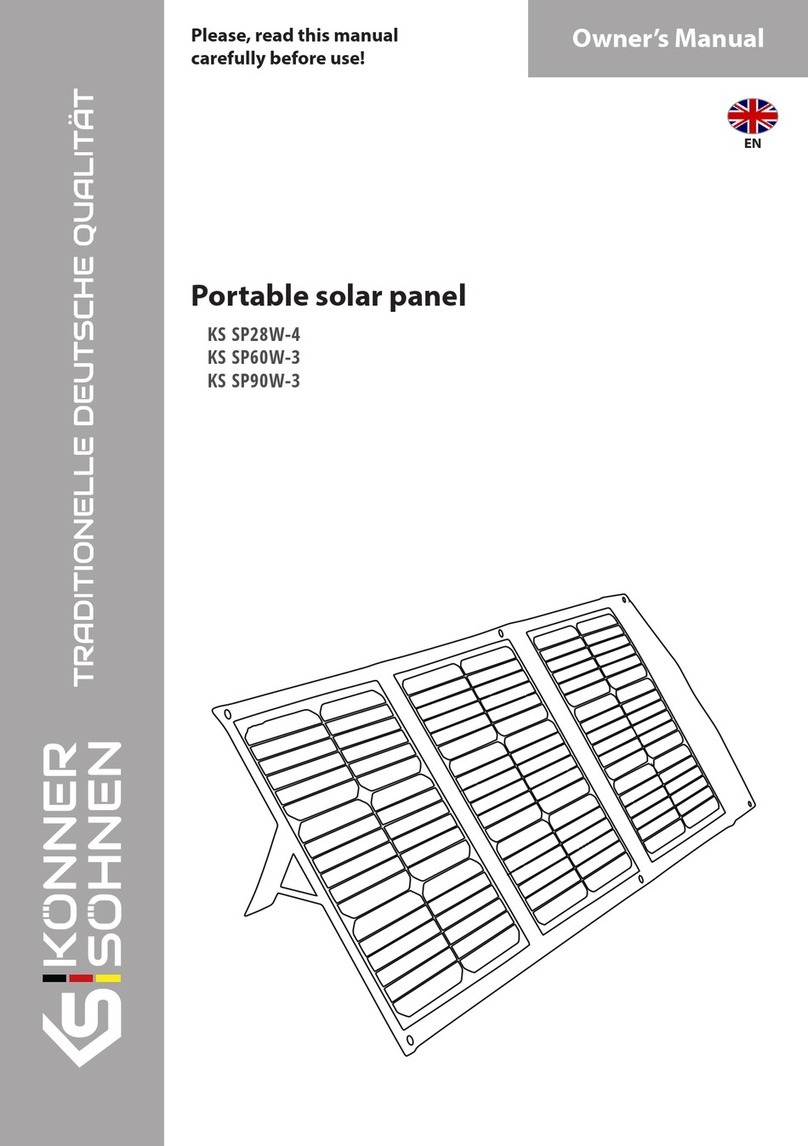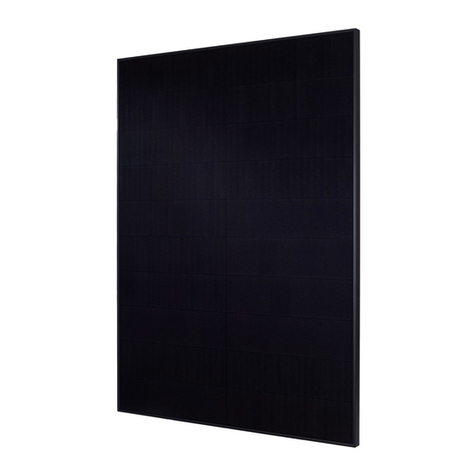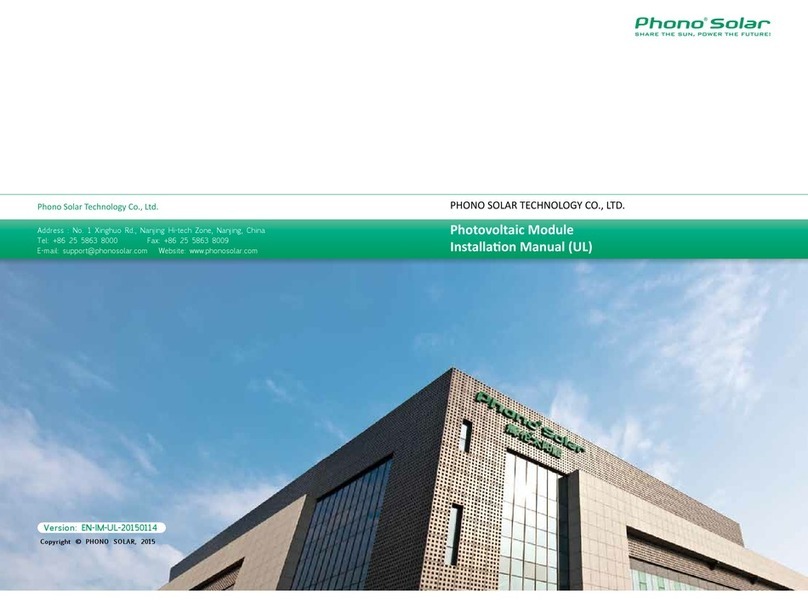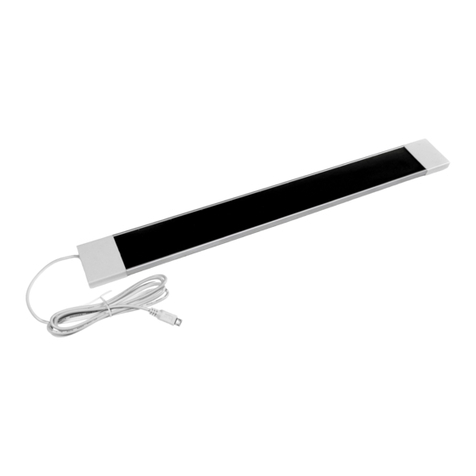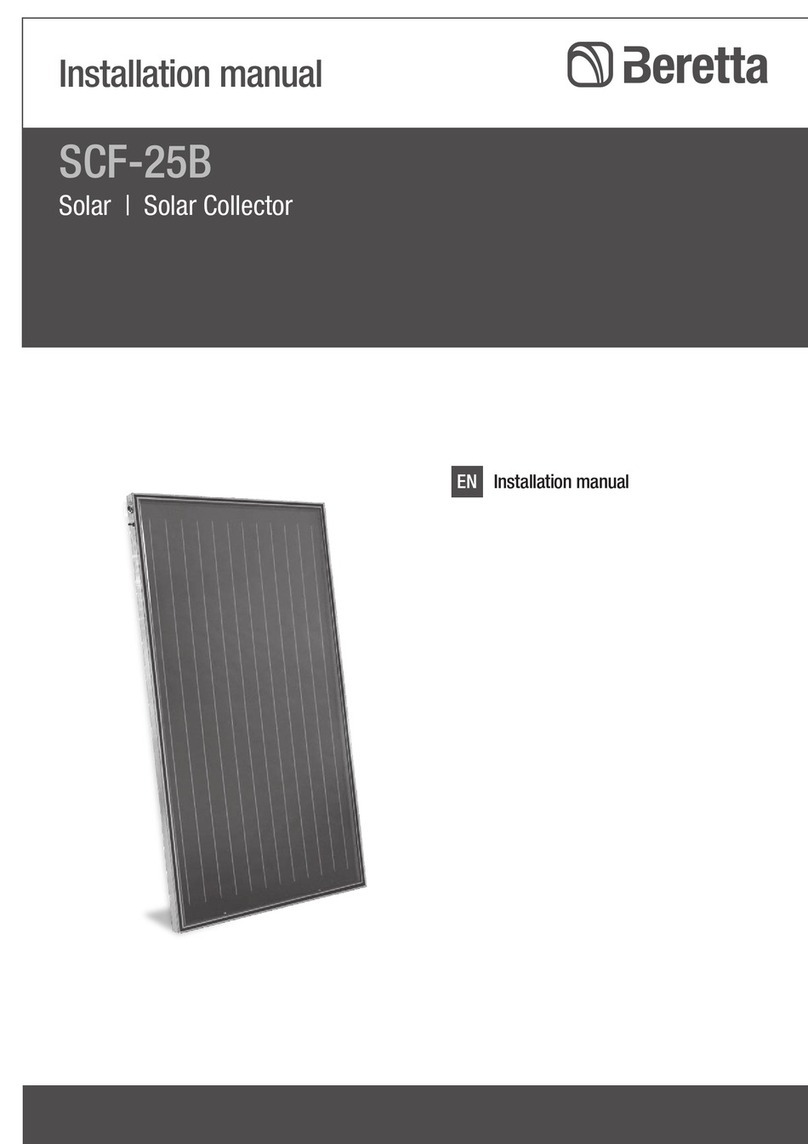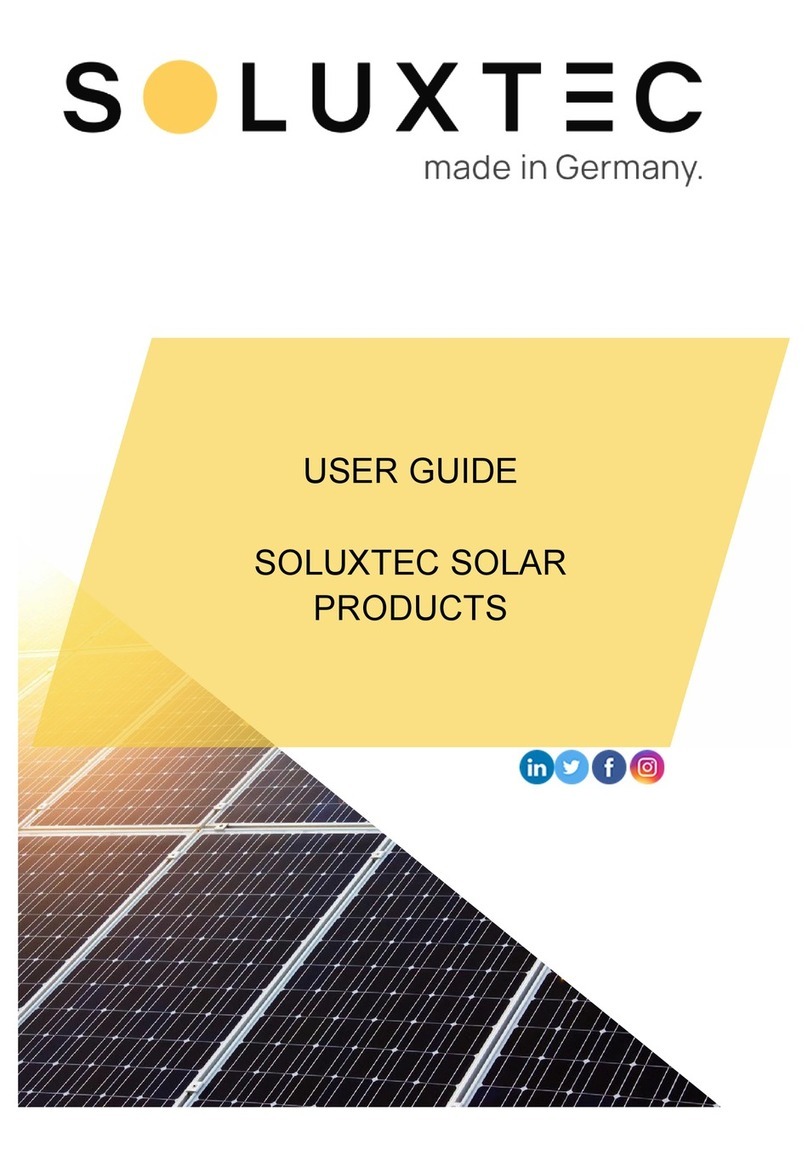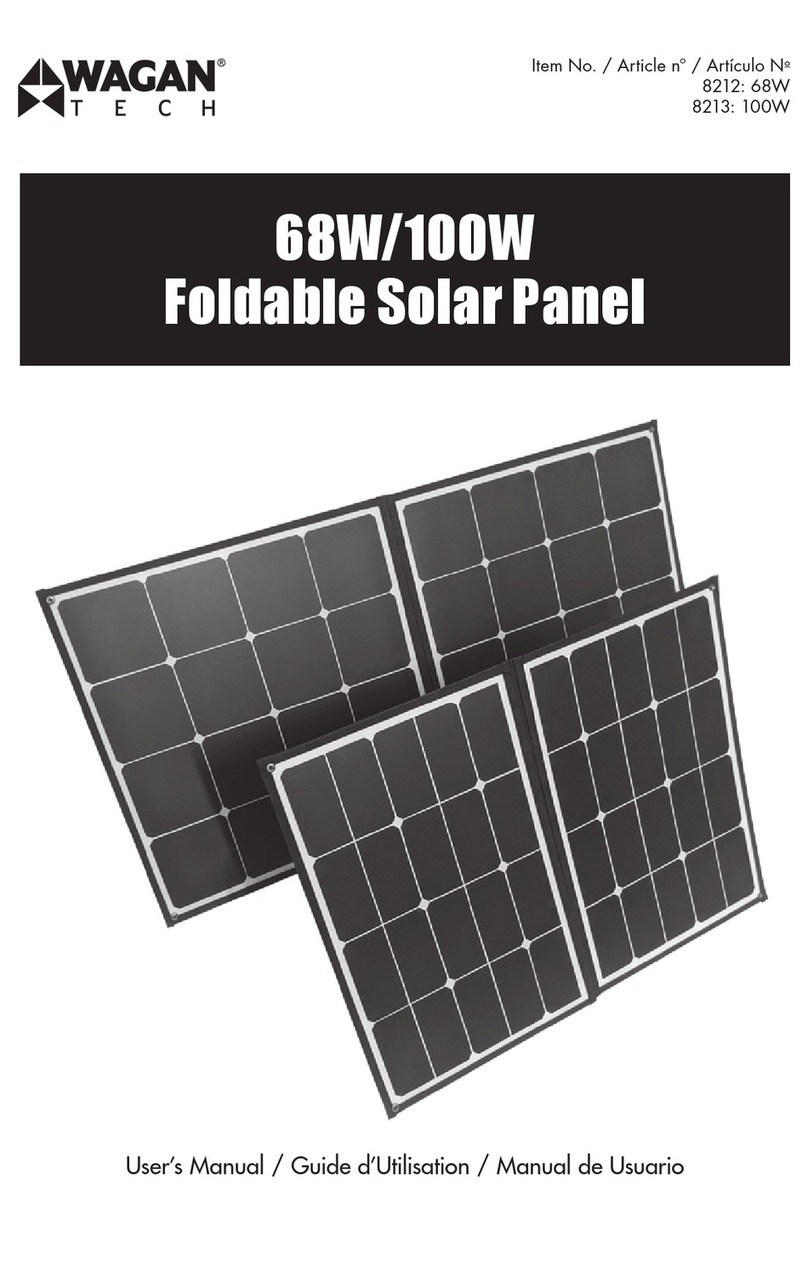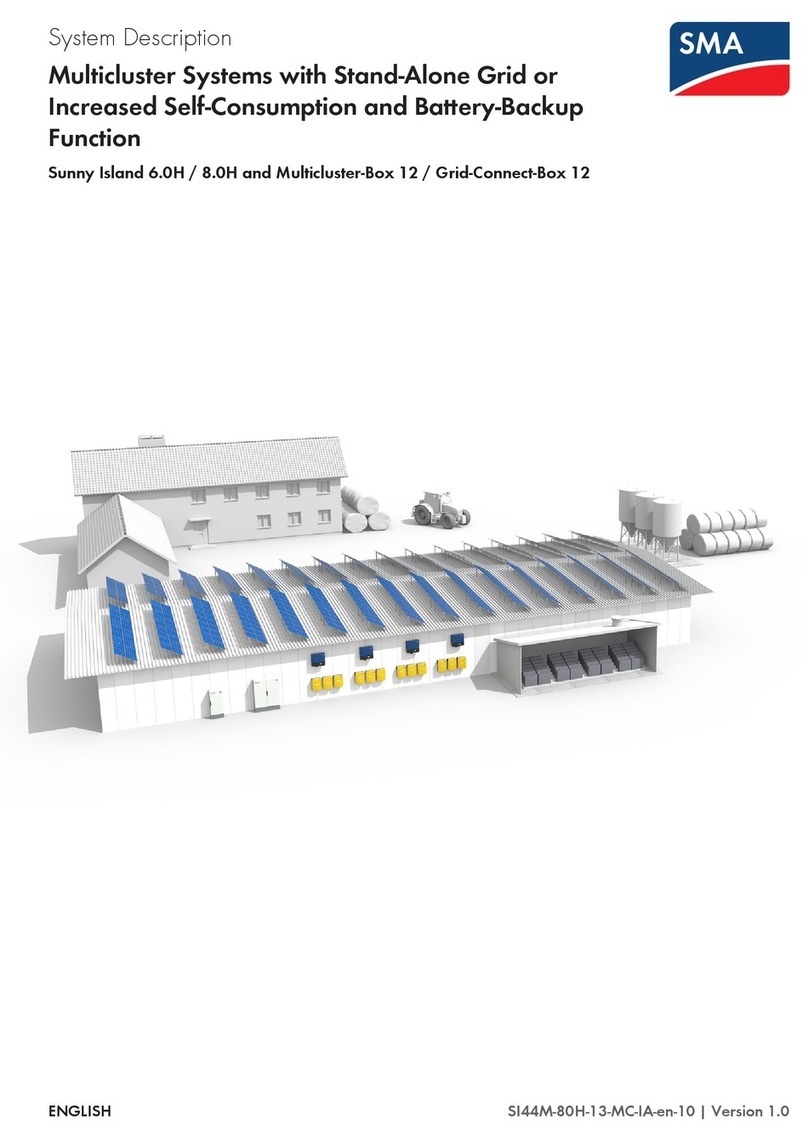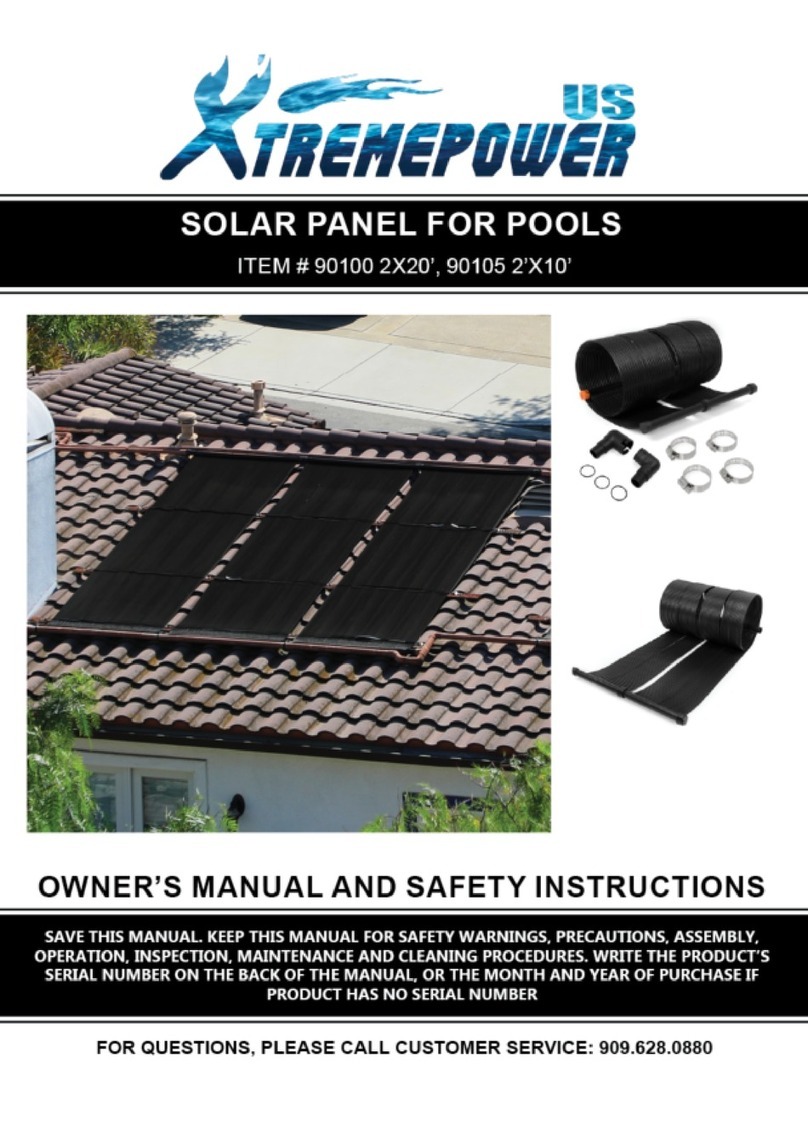Taurus PFB-0450-TG User manual

PFB-0450-TG
Panel
FULL BLACK
Manual instalación
Installation manual



1. Tornillo de acero inox. Stainless steel bolt M4 x 30
2. Tuerca de acero inox. Stainless steel nut M4
3. Arandela de acero inoxidable. Stainless steel spring washer M4
4. 6.Arandela plana de acero inox. Stainless steel flat washer M4
5. Arandela de acero inox dentada. Stainless steel locck-toothed
washer M4
7. Arandela de copa de acero inox. Stainless steel cup washer M4
8. Toma de tierra. Grounding wire
Lado afilado
Sharp point

Tabla1.
Tipo Nombre o
Modelo No:
Type Name or
Model No. :
TAU-420W-
144M(M6)
TAU-425W-
144M(M6)
TAU-430W-
144M(M6)
TAU-435W-
144M(M6)
TAU-440W-
144M(M6)
TAU-445W-
144M(M6)
TAU-450W-
144M(M6)
Voltaje de potencia
máximo (Vmp)
Maximum Power
Voltage(Vmp)
40.18
40.32
40.45
40.58
40.71
40.84
40.96
Corriente de potencia
máxima (Imp)
Maximum Power
Current (Imp)
10,46
10,54
10,63
10,72
10,81
10,90
10,99
Potencia máxima
nominal [W]
Rated Maximum
Power [W]
420
425
430
435
440
445
450
Tolerancia de
Tolerance of Rating
[%] :
±3%
±3%
±3%
±3%
±3%
±3%
±3%
Corriente nominal
de cortocircuito [A:]
Rated Short Circuit
Current [A] :
11,031
1,12
11,211
1,31
1,39
11,481
1,57
Voltaje nominal de
circuito abierto [V]:
Rated Open Circuit
Voltage [V] :
48,46
48,6
48,74
48,88
49,01
49,14
49,28

Español
Manual instalación
PFB-0450-TG
RENUNCIA DE
RESPONSABILIDAD
- La instalación, manipulación y uso de los
módulos Taurus Renovables están fuera del
control de la empresa. Taurus Renovables no
asume ninguna responsabilidad por pérdidas,
daños, lesiones o gastos que resulten de una
instalación, manipulación, uso o mantenimiento
incorrectos.
- Taurus Renovables Solar no asume ninguna
responsabilidad por cualquier infracción de
patentes u otros derechos de terceros que pue-
dan resultar del uso del módulo. No se otorga
ninguna licencia implícitamente ni bajo ninguna
patente o derecho de patente.
- Las especificaciones están sujetas a cambios
sin previo aviso.
PRECAUCIONES DE
SEGURIDAD
- Se pueden generar voltajes de CC poten-
cialmente letales siempre que los módulos
fotovoltaicos se expongan a una fuente de
luz, por lo tanto, evite el contacto con partes
eléctricamente activas y asegúrese de aislar
los circuitos activos antes de intentar hacer o
romper cualquier conexión.
- Solo el personal autorizado y capacitado debe
tener acceso o realizar trabajos en los módulos
o el sistema solar.
- Cuando trabaje en conexiones eléctricas,
quítese todas las joyas metálicas, use herra-
mientas debidamente aisladas y use equipo de
protección personal adecuado para reducir el
riesgo de descarga eléctrica.
- NO se pare ni pise, dañe o raye las superficies
frontal o trasera del módulo.
- Los módulos rotos no se pueden reparar y
el contacto con cualquier superficie o marco
del módulo puede provocar una descarga
eléctrica. NO use un módulo con vidrio roto o
sustrato roto.
- NO desmonte los módulos ni retire ninguna
parte del módulo.
- Proteja los contactos del enchufe eléctrico con-
tra la corrosión y la suciedad. Asegúrese de
que todos los conectores estén libres de corro-
sión y limpios antes de realizar la conexión.
- NO instale ni manipule módulos cuando estén
mojados o durante períodos de viento fuerte.
- Asegúrese de que todas las conexiones se
realicen de forma segura sin espacios entre los
contactos. Cualquier espacio puede resultar en
un arco eléctrico que puede causar un riesgo
de incendio y / o una descarga eléctrica.
- Asegúrese de que la polaridad de cada módulo
o cadena no se invierte considerando el resto
de módulos o cadenas.
- NO concentre artificialmente la luz solar en
estos módulos solares.
- Los módulos Taurus Renovables Solar están
certificados para operar en instalaciones de
Clase A a voltajes por debajo de 1500 Vcc.
Este voltaje máximo no debe excederse en
ningún momento y, a medida que el voltaje del
módulo aumenta, por encima de los valores de
la hoja de datos, a temperaturas de funciona-
miento por debajo de 25 °C, estos deben tener-
se en cuenta al diseñar un sistema fotovoltaico.
- NO utilice agua para extinguir incendios de
origen eléctrico.
- En condiciones normales, es probable que
un módulo solar fotovoltaico produzca más
corriente y / o voltaje de lo informado en condi-
ciones de prueba estándar. En consecuencia,
el valor de Isc marcado en este módulo debe
multiplicarse por un factor de 1,25 al determi-
nar las clasificaciones de corriente del conduc-
tor, el tamaño de los fusibles y el tamaño de los
controles conectados a la salida SPV.
DESEMBALAJE Y
ALMACENAMIENTO
- En el momento de la recepción, verifique
que el producto entregado sea, de hecho, el
producto solicitado. El nombre del producto,
el subnombre y el número de serie de cada
laminado están claramente marcados en el
exterior de cada caja de embalaje.
- Deje el producto en su caja de embalaje origi-
nal hasta que esté listo para instalar.
- Almacene las cajas de embalaje en un área
limpia y seca con una humedad relativa inferior
al 85% y una temperatura ambiente entre -20 °
C y 40 ° C.
- NO apile más de la cantidad máxima permitida
de paletas una encima de la otra.
- En el lugar de instalación, asegúrese de

- mantener los módulos y en particular sus con-
tactos eléctricos limpios y secos antes de la
instalación. Si los cables del conector se dejan
en condiciones de humedad, los contactos
pueden corroerse. No se debe utilizar ningún
módulo con contactos corroídos.
- Si las tarimas se almacenan temporalmente
en el exterior, coloque una cubierta protectora
sobre la tarima para protTaurus Renovablesrla
de la intemperie directa y no apile más de una
tarima en altura.
- Se necesitan dos personas para desembalar
los módulos de la caja de embalaje; cuando
manipule los módulos, utilice siempre ambas
manos.
- NO use un cuchillo para cortar las bridas, use
alicates para cortar alambre.
- NO coloque módulos directamente uno encima
del otro.
- Fig. 1
IDENTIFICACIÓN DE
PRODUCTO
- Cada módulo individual tiene un número de
serie único laminado detrás del vidrio y otro ad-
junto permanentemente a la hoja posterior del
módulo. Anote todos los números de serie en
una instalación para sus registros futuros.
CLASIFICACIÓN ELÉCTRICA
- Tabla 1
CONSIDERACIONES
AMBIENTALES
CONDICIONES CLIMATICAS
- Los módulos de la serie Taurus Renovables
Solar Crystalline pueden instalarse en las
siguientes condiciones durante más de 25
años. Además de la certificación requerida
para cumplir con los estándares europeos, los
productos Taurus Renovables Solar también
se han probado para verificar la resistencia a
los vapores de amoníaco que pueden estar
presentes alrededor de los establos que al-
bergan al ganado, así como su idoneidad para
su instalación en áreas húmedas (costeras) y
áreas con mucha arena. tormentas.
- Ambiente
- Temperatura ambiente: -20°C a +40°C.
- Temperatura de funcionamiento: -40°C a
+85°C.
- Temperatura de almacenamiento: -20°C a
+50°C.
- Humedad: < 85RH%
- Presión de carga mecánica *: la presión de
diseño es 3600 (frontal) / 1600 (posterior) y el
factor de seguridad es 1,5
NOTAS:
- Los módulos han sido evaluados por un labo-
ratorio acreditado para una carga máxima de
diseño inferior a 112,78 lb / pie2 (5400 Pa)
- El soporte de carga mecánica depende de los
métodos de montaje utilizados y no seguir las
instrucciones de este manual puede resultar en
diferentes capacidades para soportar cargas
de nieve y viento.
- El instalador del sistema debe asegurarse
de que los métodos de instalación utilizados
cumplan con estos requisitos y con los códigos
y regulaciones locales.
SELECCIÓN DEL SITIO
- Los módulos solares Taurus Renovables se
pueden montar en orientación horizontal y
vertical, sin embargo, el impacto de la sucie-
dad que sombrea las células solares se puede
minimizar al orientar el producto en vertical.
- Para una producción de energía óptima, los
módulos solares deben montarse normalmente
mirando hacia el ecuador en un ángulo con el
plano horizontal equivalente a la latitud de la
instalación. En el caso de que monte los módu-
los solares en un ángulo u orientación diferen-
te, la producción anual de energía puede verse
potencialmente afectada negativamente.
- Cuando instale módulos solares en un techo,
deje siempre un área de trabajo segura entre
el borde del techo y el borde externo del panel
solar.
- Coloque los módulos para minimizar las
posibilidades de sombra en cualquier momento
del día. El sombreado normalmente se puede
minimizar asegurándose de que la distancia
entre la obstrucción y el panel solar sea mayor
que tres veces la altura de la obstrucción.
- Para no afectar la clasificación contra incen-
dios, el ángulo de instalación debe ser inferior
a 5 pulg / pie.
- Evite utilizar un método de montaje que blo-
quee los orificios de drenaje en el marco del
módulo.
- Cuando todos los módulos solares están mon-
tados en el mismo plano y orientación, se pue-

de esperar que todos tengan un rendimiento
- similar a lo largo del día y se puedan conectar
juntos al mismo canal inversor.
- Si los módulos solares en la misma instalación
se montan en diferentes ángulos u orientacio-
nes, la producción de energía normalmente se
puede optimizar conectando las diferentes ori-
entaciones a diferentes inversores (o diferentes
MPPT si el inversor tiene más de un MPPT).
Consulte con los fabricantes de inversores
para obtener más pautas.
- No instale módulos en un lugar donde se su-
mergirán o expondrán continuamente al agua.
- Los módulos solares Taurus Renovables han
pasado la prueba de corrosión por niebla sa-
lina de los módulos fotovoltaicos y se pueden
instalar de forma segura en áreas salinas cor-
rosivas cercanas al océano o áreas sulfurosas.
- Los módulos solares Taurus Renovables han
pasado la prueba de corrosión por amoniaco
de los módulos fotovoltaicos y se pueden in-
stalar de forma segura en entornos con mucho
amoniaco, como las granjas.
- Altitud de aplicación de módulos solares Tau-
rus Renovables: <2000 m.
INSTRUCCIONES DE
MONTAJE
MÉTODOS DE MONTAJE
- Los módulos fotovoltaicos se pueden montar
en la subestructura utilizando pernos M8 a
prueba de corrosión colocados a través de los
orificios de montaje en la parte posterior del
módulo o abrazaderas de módulo especial-
mente diseñadas.
- Independientemente del método de fijación, la
instalación final de los módulos debe garanti-
zar que:
- Se proporciona un espacio libre de al menos
115 mm entre el marco de los módulos y la
superficie de la pared o el techo.
- La distancia mínima entre dos módulos es de
10 mm.
- El método de montaje no bloquea los orificios
de drenaje del módulo.
- Los paneles no están sujetos a cargas de
viento o nieve que excedan las cargas máxi-
mas permitidas, y no están sujetos a fuerzas
excesivas debido a la expansión térmica de las
estructuras de soporte.
MONTAJE CON PERNOS
- El marco de cada módulo tiene 8 orificios de
montaje de φ9 mm, en una ubicación ideal
para optimizar la capacidad de manejo de car-
ga, para asegurar los módulos a la estructura
de soporte.
- Para maximizar la longevidad del montaje,
Taurus Renovables Solar recomienda enca-
recidamente el uso de fijaciones a prueba de
corrosión (acero inoxidable)
- Asegure el módulo en cada lugar de fijación
con un perno M8mm y una arandela plana,
arandela de resorte y tuerca como se muestra
en la Figura 1 y apriete a un par de 16 Nm.
- Fig. 2
MONTAJE CON ABRAZADERAS
- Taurus Renovables Solar ha probado sus
módulos con varias abrazaderas de diferentes
fabricantes y recomienda el uso de abraza-
deras que tengan una arandela aislante de
EPDM o similar, perno de fijación de al menos
M6. La abrazadera debe superponerse al
marco del módulo al menos 7 mm pero no más
de 10 mm.
- Utilice como mínimo 4 abrazaderas para fijar
módulos en los rieles de montaje.
- Las abrazaderas de los módulos no deben
entrar en contacto con el vidrio frontal y no
deben deformar el marco.
- Asegúrese de evitar efectos de sombra de las
abrazaderas del módulo.
- El marco del módulo no debe modificarse bajo
ninguna circunstancia.
- Al elegir este tipo de método de montaje con
abrazadera, utilice al menos cuatro abraza-
deras en cada módulo; se deben colocar dos
abrazaderas en cada lado largo del módulo
(para orientación vertical) y en cada lado
corto del módulo (para orientación horizontal).
Dependiendo de las cargas de viento y nieve
locales, es posible que se requieran abra-
zaderas adicionales para garantizar que los
módulos puedan soportar la carga.
- El torque aplicado debe referirse al estándar
de diseño mecánico de acuerdo con el perno
que el cliente esté usando, por ejemplo: M6 es
8N * M; M8 es 16N * M
- Fig. 3
- Se pueden usar otras configuraciones de
montaje; sin embargo, el incumplimiento de
las recomendaciones anteriores dará como
resultado una reducción de las capacidades de
manejo de carga (carga de nieve / viento) por

debajo de la especificación del producto 5400 /
2400Pa y no se producirá una falla del produc-
to como resultado de una situación de
- sobrecarga. estar cubierto por la garantía.
TOMA DE TIERRA
- Todos los marcos de módulos y bastidores de
montaje deben estar debidamente conectados
a tierra de acuerdo con el Código Nacional
Eléctrico correspondiente.
- La conexión a tierra adecuada se logra uni-
endo la (s) estructura (s) del módulo y todos
los miembros estructurales metálicos juntos
de manera continua utilizando un conductor
de conexión a tierra adecuado. El conductor
o correa de conexión a tierra puede ser de
cobre, aleación de cobre o cualquier otro
material aceptable para su uso como conduc-
tor eléctrico según los respectivos códigos
eléctricos nacionales. El conductor de puesta
a tierra debe entonces hacer una conexión a
tierra utilizando un electrodo de puesta a tierra
adecuado.
- Los módulos Taurus Renovables Solar se
pueden instalar con el uso de dispositivos
de puesta a tierra listados por terceros para
conectar a tierra los marcos metálicos de los
módulos fotovoltaicos. Los dispositivos deben
instalarse de acuerdo con las instrucciones
especificadas por el fabricante del dispositivo
de conexión a tierra.
- Taurus Renovables Solar recomienda utilizar
las siguientes formas de conexión a tierra:
- Uso de Schleter para la conexión a tierra. Co-
nexión de módulos a la estructura de soporte
de acuerdo con la imagen siguiente. (Los
accesorios de puesta a tierra deben pasar la
prueba estándar UL467).
- Fig. 4
- El par recomendado es de 20,5 Nm
- Para obtener más información, póngase en
contacto con el proveedor Schletter: www.
solar.schletter.de
- La forma tradicional de conexión a tierra (Los
accesorios de conexión a tierra deben pasar
la prueba estándar UL467 y la prueba UL
E34440 / E6207).
- Fig. 5
- Para una conexión a tierra completa, el hard-
ware de conexión a tierra debe penetrar la
capa de oxidación anódica del marco.
- Cable de conexión a tierra de cobre desnudo
recomendado de 10-12 AWG.
CABLEADO DEL MÓDULO
- Todo el cableado debe ser realizado por
instaladores calificados, de acuerdo con los
códigos y regulaciones locales.
- Los módulos se pueden conectar en serie
para aumentar la tensión de funcionamiento
enchufando el enchufe positivo de un módulo
en el enchufe negativo del siguiente. Antes de
conectar los módulos, asegúrese siempre de
que los contactos estén libres de corrosión,
limpios y secos.
- El producto puede sufrir daños irreparables si
se conecta una cadena de matriz en polaridad
inversa a otra. Verifique siempre el voltaje y la
polaridad de cada cadena individual antes de
realizar una conexión en paralelo. Si mide una
polaridad invertida o una diferencia de más de
10 V entre cadenas, verifique la configuración
de la cadena antes de realizar la conexión.
- Los módulos Taurus Renovables Solar se
suministran con cables de cobre trenzados
con un área de sección transversal de 4 mm²
que están clasificados para 1500 V CC, 90
° C y son resistentes a los rayos UV. Todos
los demás cables utilizados para conectar el
sistema de CC deben tener una especificación
similar (o mejor). Taurus Renovables Solar re-
comienda que todos los cables se coloquen en
conductos adecuados y estén ubicados lejos
de áreas propensas a la acumulación de agua.
- La tensión máxima del sistema debe ser menor
que la tensión máxima certificada (normalmen-
te 1500 V) y la tensión máxima de entrada del
inversor y de los demás dispositivos eléctricos
instalados en el sistema. Para asegurarse
de que este sea el caso, el voltaje de cir-
cuito abierto de la cadena del arreglo debe
calcularse a la temperatura ambiente más baja
esperada para la ubicación. Esto se puede
hacer usando la siguiente fórmula.
- Voltaje del sistema N × Voc × 1 TCvoc × 25
Tmin
NOTAS:
- N: No hay módulos en serie
- Voc: voltaje de circuito abierto de cada módulo
(consulte la etiqueta del producto o la hoja de
datos)
- TCvoc: coeficiente térmico de voltaje de cir-
cuito abierto para el módulo (consulte la tabla
(agregar))
- Tmin: temperatura ambiente minima
- Los diámetros exteriores mínimo y máximo del
cable son de 5 a 7 mm2.

- Para conexiones de campo, use cables de
cobre de al menos 4 mm2 aislados para un mí-
nimo de 90 ° C y resistencia a la luz solar con
aislamiento designado como cable fotovoltaico.
- El radio de curvatura mínimo de los cables
debe ser de 43 mm. Fig. 6
CONFIGURACION ELECTRICA
- Los sistemas fotovoltaicos (eléctricos) funci-
onan automáticamente y requieren muy poca
supervisión diaria. La matriz solar genera
electricidad de CC siempre que la luz incida
sobre ella, de manera similar, el inversor se
enciende automáticamente tan pronto como
hay suficiente energía de la matriz solar para
convertirla de manera eficiente en energía de
CA de calidad de red.
PRECAUCIÓN:
- El módulo está clasificado para funcionar con
voltajes de CC potencialmente letales que
pueden causar descargas eléctricas graves,
arcos eléctricos y peligros de incendio. Si bien
algunos módulos solares, fabricados por Tau-
rus Renovables Solar, están certificados para
funcionar hasta 1500 V CC, siempre verifique
la etiqueta del módulo para confirmar la clasifi-
cación real de su producto antes de realizar las
conexiones.
- Utilice siempre un aislador (interruptor de CC)
con la capacidad adecuada para interrumpir
el flujo de corriente antes de desconectar los
conectores.
FUSION
- Cuando se instalan fusibles, deben tener una
capacidad nominal para el voltaje máximo de
CC y conectarse en cada polo no conectado
a tierra de la matriz (es decir, si el sistema no
está conectado a tierra, los fusibles deben
conectarse tanto en el polo positivo como en el
negativo).
- La clasificación máxima de un fusible conec-
tado en serie con una cadena de matriz es
típicamente 20 A, pero la clasificación especí-
fica del módulo real se puede encontrar en la
etiqueta del producto y en la hoja de datos del
producto.
- Este valor nominal del fusible también
corresponde a la corriente inversa máxima
que puede soportar un módulo (cuando una
cadena está sombreada, las otras cadenas
paralelas de módulos se cargarán mediante la
cadena sombreada y la corriente fluirá) y, por
lo tanto, afecta el número de cadenas en paral-
elo. Configuraciones de módulos en paralelo:
capacidad de fusible / Isc.
SELECCIÓN Y COMPATIBILIDAD DE
INVERSORES
- Cuando se instalan en sistemas regidos por
las normas IEC, los módulos Taurus Reno-
vables Solar normalmente no necesitan estar
conectados electrónicamente a tierra y, por lo
tanto, pueden funcionar junto con inversores
aislados galvánicamente (con transformador) y
sin transformador.
- En ocasiones, se observa degradación poten-
cial inducida (PID) en los módulos fotovoltaicos
debido a una combinación de alta humedad,
alta temperatura y alto voltaje. Es más probab-
le que PID cause degradación en las siguien-
tes condiciones:
- A Instalaciones en los climas cálidos y
húmedos
- B Instalación cerca de una fuente de hume-
dad continua, como cuerpos de agua
- Para reducir el riesgo de PID, recomendamos
encarecidamente que los módulos incorporen
la tecnología Anti-PID de Taurus Renovables
Solar, que puede aplicarse a cualquier produc-
to Taurus Renovables. Alternativamente, reco-
mendamos el uso de un inversor que incluya
un transformador, así como una conexión a
tierra adecuada del tramo de CC negativo del
campo fotovoltaico.
- Elija inversores con transformadores de aisla-
miento en áreas calientes y húmedas (como
costas, humedales), para garantizar que el
módulo funcione correctamente bajo voltaje
positivo.
DIODO DE BLOQUEO
- En un sistema que usa una batería, los diodos
de bloqueo generalmente se colocan entre la
batería y la salida del módulo para evitar que
la batería se descargue durante la noche y en
clima lluvioso.
- Los diodos que se utilizan como diodos de
bloqueo deben tener:
- Corriente directa promedio nominal IF (AV) por
encima de la corriente máxima del sistema a
la temperatura de funcionamiento más alta del
módulo.
- Voltaje inverso de pico repetitivo nominal
VRRM por encima del voltaje máximo del sis-
tema Vmax a la temperatura de funcionamiento
más baja del módulo IEC Vmax = 1000V UL
Vmax = 600V.
BYPASS DIODE
- El sombreado parcial de un módulo individual
puede causar un voltaje inverso en el módulo

sombreado. Luego, la corriente es forzada
a pasar por el área sombreada por los otros
módulos. Cuando se conecta un diodo de
derivación en paralelo con la cadena en serie,
la corriente forzada fluirá a través del diodo y
evitará el módulo sombreado, minimizando así
el calentamiento del módulo y las pérdidas de
corriente de la matriz.
- Modelo de diodo de derivación: 25PV045
MANTENIMIENTO Y CUIDADO
- Un sistema solar bien diseñado requiere un
mantenimiento mínimo; sin embargo, el rendi-
miento y la confiabilidad del sistema se pueden
mejorar siguiendo algunos pasos simples.
Maintenance should be carried out at least
once a year by trained personnel.
- Recorte cualquier vTaurus Renovablestación
que pueda dar sombra a la matriz solar y afec-
tar el rendimiento.
- Verifique que los accesorios de montaje estén
bien apretados.
- Inspeccione todos los cables para verificar que
las conexiones estén firmes; los cables están
protegidos de la luz solar directa y ubicados
lejos de áreas de recolección de agua.
- Compruebe que todos los fusibles de cade-
na en cada polo no conectado a tierra estén
funcionando.
- En el caso de que sea necesario limpiar los
módulos solares, limpie el módulo con un
paño suave junto con un detergente suave y
agua limpia. Tenga cuidado de evitar choques
térmicos severos que puedan dañar el módulo
limpiando los módulos con agua a una tempe-
ratura similar a la de los módulos que se están
limpiando.
- En sistemas grandes, el beneficio de limpiar la
suciedad y los desechos de la matriz es una
compensación entre el costo de la limpieza,
el aumento de la producción de energía como
resultado de esta limpieza y el tiempo para
volver a ensuciar los módulos después de la
limpieza.
- Si no está seguro de si es necesario limpiar la
matriz o una sección de la misma, seleccione
primero una cadena de matriz que esté parti-
cularmente sucia y luego:
- Mida y registre la alimentación del inversor en
la corriente de esa cadena
- Limpiar todos los módulos de la cadena
- Mida de nuevo la alimentación del inversor
en corriente y calcule el% de mejora de la
limpieza
- Si la mejora es inferior al 5%, normalmente no
vale la pena gastar el gasto en limpieza.
- La verificación anterior solo debe llevarse a
cabo cuando la insolación sea efectivamente
constante (cielo despejado, sol fuerte, sin
nubes)
- Normalmente, no es necesario limpiar la
superficie trasera del módulo, pero, en caso
de que se considere necesario, evite el uso de
proyectos afilados que puedan dañar el materi-
al que penetra en el sustrato.
ADVERTENCIA
- Estos módulos solares no contienen ninguna
pieza que pueda reparar el usuario.
- Si sospecha que su instalación no está funci-
onando correctamente, comuníquese con su
instalador inmediatamente.
- Póngase en contacto con su instalador
- Póngase en contacto con el equipo de servicio
posventa de Taurus Renovables Solar en:
www.taurusrenovables.com
- ADVERTENCIA: Para cualquier mantenimien-
to eléctrico, primero se debe apagar el sistema
fotovoltaico. Un mantenimiento inadecuado
puede provocar descargas eléctricas letales y /
o quemaduras.
INFORMACIÓN DE CONTACTO
- ENGINEERING AND TECHNOLOGY FOR
LIFE, S.L.U.
- Av. Barcelona s/n. 25790 Oliana · España
- Telf: +34 973 470 550

English
Installation manual
PFB-0450-TG
DISCLAIMER OF LIABILITY
- The installation, handling and use of Taurus
Renovables modules are beyond company
control. Taurus Renovables does not assume
any responsibility for loss, damage, injury or
expense resulting from the improper installati-
on, handling, use or maintenance.
- Taurus Renovables Solar assumes no respon-
sibility for any infringement of patents or other
rights of third parties that may result from use
of the module. No license is granted by implica-
tion or under any patent or patent rights.
- Specifications are subject to change without
prior notice.
SAFETY PRECAUTIONS
- Potentially lethal DC voltages can be gene-
rated whenever PV Modules are exposed to
a light source therefore, avoid contact with
electrically active parts and be sure to isolate
live circuits before attempting to make or break
any connections.
- Only authorized and trained personnel should
have access or perform work on the modules
or solar system.
- When working on electrical connections, remo-
ve all metallic jewelry, use properly insulated
tools and wear appropriate personal protective
equipment to reduce the risk of electric shock.
- Do NOT stand or step on, damage or scratch
the front or backside surfaces of the module.
- Broken modules cannot be repaired and cont-
act with any module surface or frame can lead
to electrical shock. Do NOT use a module with
broken glass or torn substrate.
- Do NOT disassemble the modules or remove
any part of the module.
- Protect the electrical plug contacts against
corrosion and soiling. Make sure that all
connectors are corrosion free and clean before
making the connection.
- Do NOT install or handle modules when they
are wet or during periods of high wind.
- Ensure sure that all connections are securely
made with no gap between the contacts. Any
gap can result in electrical arcing that can cau-
se a fire hazard and/or an electric shock.
- Make sure that the polarity of each module or
a string is not reversed considering the rest of
the modules or strings.
- Do NOT artificially concentrate sunlight on
these solar modules.
- Taurus Renovables Solar modules are certified
for operating in Class A installations at voltages
below 1500Vdc. This maximum voltage should
not be exceeded at any time and, as the volta-
ge of the module increases, above data sheet
values, at operating temperatures below 25°C,
then these need to be taken into account when
designing a PV system.
- Do NOT use water to extinguish fires of an
electrical origin.
- Under normal conditions, a solar photovoltaic
module is likely to produce more current and /
or voltage than reported under standard test
conditions. Accordingly, the value of Isc mar-
ked on this module should be multiplied by a
factor of 1.25 when determining the conductor
current ratings, fuse sizes and size of controls
connected to the SPV output.
UNPACKING AND STORAGE
- At time of receipt, verify that the product deli-
vered is in fact the product ordered the product
name, subname, and serial number of each
laminate are clearly marked on the outside of
each packing box.
- Leave the product in its original packing box
until you are ready to install.
- Store packing boxes in a clean, dry area with
relative humidity below 85% and ambient tem-
peratures between -20°C and 40°C.
- Do NOT stack more than the maximum amount
of allowable pallets on top of each other.
- At the installation site, take care to keep modu-
les and particular their electrical contacts clean
and dry before installation. If connector cables
are left in damp conditions then the contacts
may corrode. Any module with corroded cont-
acts should not be used.
- If pallets are stored temporarily outside then
place a protective covering over the pallet to
protect it from direct weathering and do not
stack more than one pallet high.
- Two people are required to unpack the mo-
dules from the packing box, when handling
modules always use both hands.
- Do NOT use a knife to cut the zip-ties, but use
wire cutting pliers.

- Do NOT place modules directly on top of each
other.
- Fig. 1
PRODUCT IDENTIFICATION
- Each individual module has a unique serial
number laminated behind the glass and ano-
ther permanently attached to the back-sheet
of the module. Note all serial numbers in an
installation for your future records.
ELECTRICAL RATING
- Table 1.
ENVIRONMENTAL
CONSIDERATIONS
CLIMATE CONDITIONS
- Taurus Renovables Solar Crystalline series
modules may be installed in the following
conditions for more than 25 years. In addition
to the required certification to meet European
standards Taurus Renovables Solar products
have also been tested to verify resistance to
ammonia fumes that may be present around
barns sheltering cattle, as well as suitability for
installation in humid (coastal) areas and areas
of high sand storms.
- Environment
- Ambient temperature: -20°C to +40°C.
- Operating temperature: -40°C to +85°C.
- Storage temperature: -20°C to +50°C.
- Humidity: < 85RH%
- Mechanical Load Pressure*: The design pres-
sure is 3600 (front)/1600 (back) and the safety
factor is 1.5
NOTES:
- The modules have been evaluated by an accre-
dited laboratory for a maximum design loading
of below 112.78lb / ft2 (5400Pa)
- The mechanical load bearing is dependent
upon the mounting methods used and failure
to follow the instructions of this manual may
result in different capabilities to withstand snow
and wind loads. The system installer must
ensure that the installation methods used meet
these requirements and any local codes and
regulations.
SITE SELECTION
- Taurus Renovables Solar Modules can be
mounted in landscape and portrait orientation
however the impact of dirt shading the solar
cells can be minimized by orienting the product
in portrait.
- For optimum energy production, solar modules
should normally be mounted facing the equator
at an angle to the horizontal plane equivalent
to the latitude of the installation. In the event
that you mount the solar modules at a different
angle or orientation then the annual ener-
gy production may potentially be adversely
impacted.
- When installing solar modules on a roof always
leave a safe working area between the edge
of the roof and the external edge of the solar
array.
- Position the modules to minimize the chances
of shading at any time of the day. Shading can
normally be minimized by ensuring that the
distance between the obstruction and solar
array is greater than three times the obstructi-
on’s height.
- In order not to affect the fire rating, installation
angle must be less than 5 in/ft.
- Avoid using a mounting method that will block
the drainage holes in the module frame.
- When all solar modules are mounted in the
same plane and orientation then all can be ex-
pected to have similar performance throughout
the day and can be connected together to the
same inverter channel.
- If solar modules on the same installation are
mounted at different angles or orientations then
energy production can normally be optimized
by connecting the different orientations to diffe-
rent inverters (or different MPPT if the inverter
has more than one MPPT). Refer to inverter
manufacturers for further guidelines.
- Do not install modules in a location where they
will be immersed in or continually exposed to
water.
- Taurus Renovables Solar Modules have pas-
sed the test of PV modules salt mist corrosion
,and can be safely installed in corrosive salt
areas within proximity of the ocean or sulfurous
areas.
- Taurus Renovables Solar Modules have pas-
sed the test of PV modules ammonia corrosion
,and can be safely installed in ammonia-heavy
environments, such as farm houses.
- Taurus Renovables Solar Modules application
altitude: <2000m.

MOUNTING INSTRUCTIONS
MOUNTING METHODS
- PV modules can be mounted to the subst-
ructure using either corrosion-proof M8 bolts
placed through the mounting holes on the rear
of the module or specially designed module
clamps.
- Regardless of the fixing method the final instal-
lation of the modules must ensure that:
- A clearance of at least 115mm is provided
between modules frame and the surface of the
wall or roof.
- The minimum distance between two modules
is 10 mm.
- The mounting method does not block the mo-
dule drainage holes.
- Panels are not subjected to wind or snow loads
exceeding the maximum permissible loads,
and are not subject to excessive forces due to
the thermal expansion of the support structu-
res.
MOUNTING WITH BOLTS
- The frame of each module has 8 x φ9mm
mounting holes, ideally placed to optimize the
load handling capability, to secure the modules
to supporting structure.
- To maximize mounting longevity, Taurus Reno-
vables Solar strongly recommends the use of
corrosion proof (stainless steel) fixings
- Secure the module in each fixing location with
an M8mm bolt and a flat washer, spring washer
and nut as shown in Figure 1 and tighten to a
torque of 16 Nm.
- Fig. 2
MOUNTING WITH CLAMPS
- Taurus Renovables Solar has tested its mo-
dules with a number of clamps from different
manufacturers and recommends the use of
clamps which have an EPDM or similar insu-
lating washer, fixing bolt of at least M6. The
clamp must overlap the module frame by at
least 7mm but no more than 10 mm.
- Use at minimum 4 clamps to fix modules on the
mounting rails.
- Modules clamps should not come into contact
with the front glass and must not deform the
frame.
- Be sure to avoid shadowing effects from the
module clamps.
- The module frame is not to be modified under
any circumstances.
- When choosing this type of clamp-mounting
method, use at least four clamps on each
module, two clamps should be attached on
each long sides of the module (for portrait
orientation) and each short sides of the module
(for landscape orientation). Depending on local
wind and snow loads, additional clamps may
be required to ensure that modules can bear
the load.
- Applied torque should refer to mechanical
design standard according to the bolt customer
is using, ex:M6 is 8N*M;M8 is 16N*M.
- Fig. 3
- Other mounting configurations can be used
however, failure to comply with the above
recommendations will result in a lowering of
the load handling (snow/wind load) capabilities
below the product specification 5400/2400Pa
and product failure as a result of an overload
situation will not be covered by the guarantee.
GROUNDING
- All module frames and mounting racks must be
properly grounded in accordance with approp-
riate respective National Electrical Code.
- Proper grounding is achieved by bonding
the module frame(s) and all metallic structu-
ral members together continuously using a
suitable grounding conductor. The grounding
conductor or strap may be copper, copper al-
loy, or any other material acceptable for use as
an electrical conductor per respective National
Electrical Codes. The grounding conductor
must then make a connection to earth using a
suitable earth ground electrode.
- Taurus Renovables Solar modules can be
installed with the use of third party listed
grounding devices for grounding the metallic
frames of PV modules. The devices have to
be installed in accordance with the grounding
device manufacturer’s specified instructions.
- Taurus Renovables Solar recommends using
the following grounding ways
- Using Schleter for grounding. Connecting mo-
dules to the support structure according to the
picture below. (Grounding accessories need
pass the UL467 standard test.)
- Fig. 4
- Recommended torque is 20.5Nm
- For more information, please contact the sup-
plier Schletter http //www.solar.schletter.de
- The traditional way of grounding Grounding

- accessories need pass the UL467 standard
test and UL E34440/E6207 test.
- Fig. 5
- For fully grounding, grounding hardware should
penetrate the anodic oxidation layer of frame.
- Recommended 10-12 AWG bare copper groun-
ding wire.
MODULE WIRING
- All wiring should be performed, by qualified
installers, in accordance with the local codes
and regulations.
- Modules can be connected in series to in-
crease the operating voltage by plugging the
positive plug of one module into the negative
socket of the next. Before connecting modules
always ensure that the contacts are corrosion
free, clean and dry.
- Product can be irreparably damaged if an array
string is connected in reverse polarity to ano-
ther. Always verify the voltage and polarity of
each individual string before making a parallel
connection. If you measure a reversed polarity
or a difference of more than 10V between
strings then check the string configuration
before makingthe connection.
- Taurus Renovables Solar modules are provi-
ded with stranded copper cables with a cross
sectional area of 4mm² which are rated for
1500Vdc, 90°C and are UV resistant. All other
cables used to connect the DC system should
have a similar (or better) specification. Taurus
Renovables Solar recommend that all cables
are run in appropriate conduits and sited away
from areas prone to water collection.
- The maximum voltage of the system must
be less than the maximum certified voltage
(1500V typically) and the maximum input vol-
tage of the inverter and of the other electrical
devices installed in the system. To ensure that
this is the case, the open circuit voltage of
the array string needs to be calculated at the
lowest expected ambient temperature for the
location. This can be done using the following
formula.
- System voltage N × Voc × 1 TCvoc × 25 Tmin
NOTES:
- N: No modules in series
- Voc: Open circuit voltage of each module (refer
to product label or data sheet)
- TCvoc: Thermal coefficient of open circuit vol-
tage for the module (refer to table (add))
- Tmin: Minimum ambient temperature
- The minimum and maximum outer diameters of
the cable are 5 to 7mm2.
- For field connections, use at least 4 mm2 cop-
per wires insulated for a minimum of 90°C and
sunlight resistance with insulation designated
as PV Wire.
- The minimum bending radius cables should be
43mm.
- Fig. 6
ELECTRICAL
CONFIGURATION
- Photovoltaic (electric) systems operate au-
tomatically and require very little day-to-day
supervision. The solar array generates DC
electricity whenever light falls on it similarly
the inverter automatically turns ON as soon as
there is sufficient energy from the solar array
to efficiently convert this into grid quality AC
power.
CAUTION:
- The module is rated to operate at potentially
lethal DC voltages which have the potential can
cause severe electrical shock, arcing and fire
hazards. Whilst some solar modules, manufac-
tured by Taurus Renovables Solar, are certified
to operate up to 1500V dc always check the
module label to confirm the actual rating of
your product before making connections.
- Always use a suitably rated isolator (DC switch)
to interrupt the current flow before disconnec-
ting the connectors.
FUSING
- When fuses are fitted they should be rated for
the maximum DC voltage and connected in
each, non-grounded pole of the array (i.e. if
the system is not grounded then fuses should
be connected in both the positive and negative
poles).
- The maximum rating of a fuse connected in se-
ries with an array string is typically 20A but the
actual module specific rating can be found on
the product label and in the product datasheet.
- This fuse rating value also corresponds to the
maximum reverse current that a module can
withstand (when one string is shaded then the
other parallel strings of modules will be loaded
by the shaded string and current will flow) and
therefore impacts the number of strings in
parallel. Parallel module configurations: fuse
rating/Isc.

INVERTER SELETION AND COMPATIBILITY
- When installed in systems governed by
IEC regulations, Taurus Renovables Solar
modules normally do not need to be electro-
nically connected to earth and therefore can
be operated together with either galvanically
isolated (with transformer) and transformerless
inverters.
- Potential Induced Degradation (PID) is
sometimes observed in PV modules due to a
combination of high humidity, high temperature
and high voltage. PID is most likely to cause
degradation under the following conditions:
- A Installations in the warm and humid climates
- B Installation close to a source of continual
moisture, such as bodies of water
- To reduce the risk of PID, we strongly suggest
that modules feature Taurus Renovables So-
lar’s Anti-PID technology, which can be applied
to any Taurus Renovables product. Alternati-
vely, we recommend the use of an inverter that
includes a transformer as well as proper groun-
ding of the negative DC leg of the PV array.
- Choose inverters with isolation transformers in
hot and wet areas (such as shores, wetlands),
to ensure proper module function under positi-
ve voltage.
BLOCKING DIODE
- In a system that uses a battery,blocking diodes
are typically placed between the battery and
the module output to prevent battery discharge
at night and rainy weather.
- Diodes that are used as blocking diodes must
have a:
- Rated Average Forward Current IF(AV) above
the maximum system current at the highest
module operating temperature.
- Rated Repetitive Peak Reverse Voltage VRRM
above the maximum system voltage Vmax at
the lowest module operating temperature IEC
Vmax = 1000V ULVmax = 600V.
BYPASS DIODE
- Partial shading of an individual module can
cause a reverse voltage across the shaded
module. Current is then forced go through the
shaded area by the other modules. When a
bypass diode is wired in parallel with the series
string, the forced current will flow through the
diode and bypass the shaded module, thereby
minimizing module heating and array current
losses.
- Bypass Diode Model: 25PV045
MAINTENANCE AND CARE
- A well designed solar system requires minimal
maintenance; however, system performance
and reliability can be improved by taking some
simple steps.
- Maintenance should be carried out at least
once a year by trained personnel.
- Trim any vTaurus Renovablestation which may
shade the solar array thus impacting perfor-
mance.
- Check that mounting hardware is properly
tightened.
- Inspect all cables to verify that connections
are tight; the cables are protected from direct
sunlight and sited away from areas of water
collection.
- Check that all string fuses in each non/earthed
pole are operating.
- In the event that the solar modules need to be
cleaned then clean the module use a soft cloth
together with a mild detergent and clean water.
Take care to avoid severe thermal shocks
which might damage the module by cleaning
modules with water which has a similar tempe-
rature to the modules being cleaned.
- On large systems, the benefit of cleaning
dirt and debris from the array is a trade-off
between the cost of the cleaning, increased
energy production as a result of this cleaning,
and the time for the re-soiling of the modules
after cleaning.
- If you are unsure whether the array or section
thereof needs to be cleaned then first select an
array string that is particularly soiled then
- Measure & record the inverter feed in current
from that string
- Clean all modules in the string
- Measure the inverter feed in current again and
calculate the % improvement from cleaning
- If the improvement is less than 5% then it is
normally nor worth spending the expense on
cleaning
- The above verification should only be carried
out when the insolation is effectively constant
(clear sky, strong sunshine, no clouds)
- The back surface of the module normally does
not need to be cleaned but, in the event this is
deemed necessary, avoid the use of any sharp
projects that might damage the penetrating the
substrate material.

WARNING
- These solar modules do not contain any user
serviceable parts,
- If you suspect that your installation is not
working properly, then contact your installer
immediately.
- Contact your installer
- Contact Taurus Renovables Solar after sales
service team at:www.taurusrenovables.com
- WARNING: For any electrical maintenance, the
PV system must first be shut down. Improper
maintenance can cause lethal electric shock
and/or burns.
CONTACT INFORMATION
- TAURUS RENOVABLES,, S.L.U.
- Av. Barcelona s/n.
- 25790 Oliana (Lérida)
- España
- Phone: +34 973 470 550


Español
GARANTÍA Y ASISTENCIA TÉCNICA
Este producto goza del reconocimiento y protec-
ción de la garantía legal de conformidad con la le-
gislación vigente. Para hacer valer sus derechos
o intereses debe acudir a cualquiera de nuestros
servicios de asistencia técnica oficiales.
Podrá encontrar el más cercano accediendo al
siguiente enlace web: http://taurus-home.com/
También puede solicitar información relacionada
poniéndose en contacto con nosotros por el telé-
fono que aparece al final de este manual.
Puede descargar este manual de instrucciones y
sus actualizaciones en http://taurus-home.com
Català
GARANTIA I ASSISTÈNCIA TÈCNICA
Aquest producte gaudeix del reconeixement i
protecció de la garantia legal de conformitat amb
la legislació vigent. Per fer valer els seus drets o
interessos ha d’acudir a qualsevol dels nostres
serveis d’assistència tècnica oficials.
Podrà trobar el més proper accedint al següent
enllaç web: http://taurus-home.com/
També pot demanar informació relacionada
posant-se en contacte amb nosaltres al telèfon
que apareix al final d’aquest manual.
Podeu descarregar aquest manual d’instruccions
i les seves actualitzacions a http://taurus-home.
com
English
WARRANTY AND TECHNICAL ASSISTANCE
This product enjoys the recognition and protection
of the legal guarantee in accordance with current
legislation. To enforce your rights or interests you
must go to any of our official technical assistance
services.
You can find the closest one by accessing the
following web link: http://taurus-home.com/
You can also request related information by
contacting us.
You can download this instruction manual and its
updates at http://taurus-home.com/
Français
GARANTIE ET ASSISTANCE TECHNIQUE
Ce produit est reconnu et protégé par la garantie
établie conformément à la législation en vigueur.
Pour faire valoir vos droits ou intérêts, vous
devrez vous adresser à l’un de nos services
d’assistance technique agréés.
Pour savoir lequel est le plus proche, vous pou-
vez accéder au lien suivant : http://taurus-home.
com/
Vous pouvez aussi nous contacter pour toute
information.
Vous pouvez télécharger ce manuel d’instructions
et ses mises à jour sur http://taurus-home.com/
Deutsch
GARANTIE UND TECHNISCHER SERVICE
Dieses Produkt ist von der gesetzlichen Garantie
gemäss der geltenden Gesetzgebung geschützt.
Um Ihre Rechte und Interessen geltend zu
machen, müssen Sie eines unserer offiziellen
Servicezentren aufsuchen.
Über folgenden Link finden Sie ein Servicezen-
trum in Ihrer Nähe: http://taurus-home.com/
Sie können auch Informationen anfordern, indem
Sie sich mit uns in Verbindung setzen.
Sie können dieses Benutzerhandbuch und seine
Aktualisierungen unter http://taurus-home.com/
Italiano
GARAZIA E ASSISTENZA TECNICA
Questo prodotto possiede il riconoscimento e la
protezione della garanzia legale di conformità con
la legislazione vigente. Per far valere i suoi diritti
o interessi, dovrà rivolgersi a uno qualsiasi dei
nostri servizi ufficiali di assistenza tecnica.
Può trovare il più vicino cliccando sul seguente
link: http://taurus-home.com/
Inoltre, può richiedere informazioni mettendosi in
contatto con noi.
Può scaricare questo manuale di istruzioni e i
suoi aggiornamenti da http://taurus-home.com/

Português
GARANTIA E ASSISTÊNCIA TÉCNICA
Este produto goza do reconhecimento e proteção
da garantia legal em conformidade com a legis-
lação em vigor. Para fazer valer os seus direitos
ou interesses, deve recorrer sempre aos nossos
serviços oficiais de assistência técnica.
Poderá encontrar o mais próximo de si através
do seguinte website: http://taurus-home.com/
Também pode solicitar informações relacionadas,
pondo-se em contacto connosco.
Pode fazer o download deste manual de
instruções e suas atualizações em http://taurus-
home.com/
Nederlands
GARANTIE EN TECHNISCHE ONDERSTEU-
NING
Dit product valt onder de legale garantievoorwa-
arden zoals bepaald in de actuele wetgeving. Om
een beroep te doen op uw rechten of aanspraken
kunt u contact opnemen met onze officiële tech-
nische service.
U kunt de dichtstbijzijnde technische service vin-
den op de website: http://taurus-home.com/
Voor verdere informatie kunt u ook contact met
ons opnemen.
U kunt deze gebruiksaanwijzing en eventuele
actualiseringen ervan downloaden via http://
taurus-home.com/
Polski
GWARANCJA I SERWIS TECHNICZNY
Ten produkt jest uznawany i chroniony prawną
gwarancją zgodnie z obowiązującymi przepisami.
W
celu wyegzekwowania swoich prawa lub inte-
resów, należy udać się do dowolnego z naszych
oficjalnych usług pomocy technicznej.
Najbliższy punkt można znaleźć, korzystając z
poniższego linku: http://taurus-home.com/
Można również poprosić o informacje, kontaktując
się z
nami.
Można też pobrać niniejszą instrukcję obsługi i jej
aktualizacje na http://taurus-home.com/
Ελληνικά
ΕΓΓΥΗΣΗ ΚΑΙ ΤΕΧΝΙΚΗ ΥΠΟΣΤΗΡΙΞΗ
Το παρόν
προϊόν
αναγνωρίζεται
και
προστατεύεται από τη νόμιμη εγγύηση συμμόρφωσης
προς την ισχύουσα νομοθεσία. Για
να διεκδικήσετε τα δικαιώματα ήσυμφέροντά σας
πρέπει
να
απευθυνθείτε
σε
ο
π
οιοδήπο
τε
από
τ
α
επίσημα γραφεία μας τεχνικής υποστήριξης.
Για να βρείτε το πιο κοντινό σε εσάς,
ανατρέξτε
στην ιστοσελίδα:
http://taurus-
home.com/
Μπ
ορείτε
επίσης
να
ζ
ητήσετε
πληροφορίες,
επικοινωνώντας μαζί
μας.
Μπ
ορείτε
να
«κ
ατεβάσετε»
από
τ
ο
διαδίκτυο το παρόν εγχειρίδιο οδηγιών και τις σχετικές
ενημερώσεις του στο
http://taurus-home.com/
Русский
ГАРАНТИЯ ИТЕХНИЧЕСКАЯ ПОДДЕРЖКА
Этот продукт защищен юридической гарантией всоответствии с
действующим законодательством. Чтобы обеспечить соблюдение
ваших
прав
или
интересов, вы должны обратиться влюбую из наших
официальных служб по технической
поддержке клиентов.
Вы можете найти ближайшие из центров,
пройдя по следующей веб-
ссылке: http://taurus-
home.com/
Вы также можете запросить соответствующую
информацию, связавшись снами
(см. последнюю страницу руководства).
Вы можете скачать это руководство и
обновления кнему по адресу
http://taurus-
home.com/
Română
GARANȚIE ȚI ASISTENȚĂ TEHNICĂ
Acest produs beneficiază de recunoașterea și
protecșia garanșiei legale în conformitatecu
legislașia în vigoare. Pentru a vă exercita
drepturile sau interesele, trebuie să vă adresași
unuia dintre serviciile noastre oficiale de asistenșă
tehnică.
Puteși găsi cel mai apropiat serviciu de asistenșă
tehnică accesând următorul link web: http://
taurus-home.com/
De asemenea, puteși solicita informașii conexe,
contactând-ne (consultași ultima pagină a manua-
lului).
Puteși descărca acest manual de instrucșiuni și
actualizările sale la http://taurus-home.com/
Table of contents
Languages:
Other Taurus Solar Panel manuals
